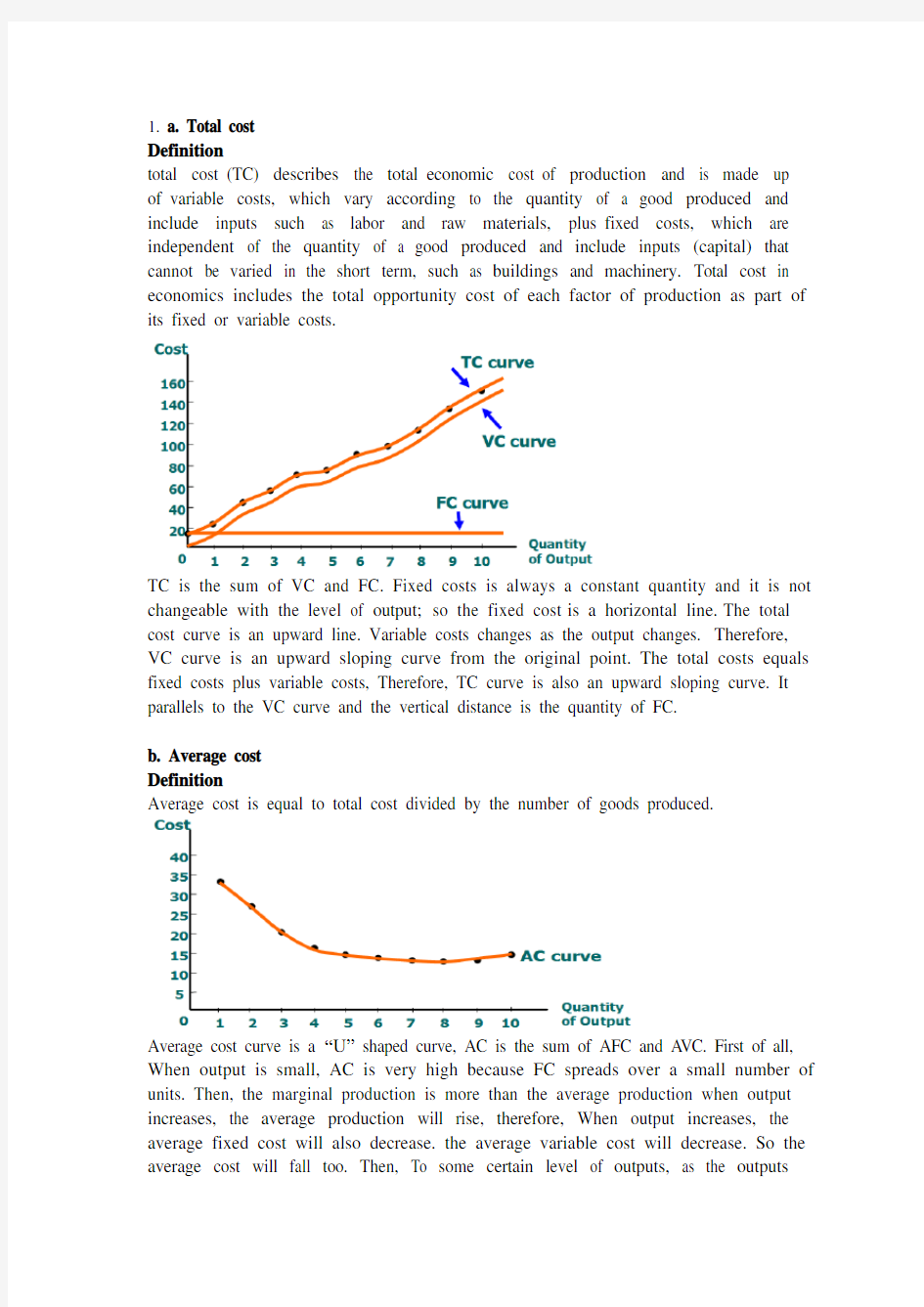微观经济学参考教学教材

- 1、下载文档前请自行甄别文档内容的完整性,平台不提供额外的编辑、内容补充、找答案等附加服务。
- 2、"仅部分预览"的文档,不可在线预览部分如存在完整性等问题,可反馈申请退款(可完整预览的文档不适用该条件!)。
- 3、如文档侵犯您的权益,请联系客服反馈,我们会尽快为您处理(人工客服工作时间:9:00-18:30)。
1. a. Total cost
Definition
total cost (TC) describes the total economic cost of production and is made up of variable costs, which vary according to the quantity of a good produced and include inputs such as labor and raw materials, plus fixed costs, which are independent of the quantity of a good produced and include inputs (capital) that cannot be varied in the short term, such as buildings and machinery. Total cost in economics includes the total opportunity cost of each factor of production as part of its fixed or variable costs.
TC is the sum of VC and FC. Fixed costs is always a constant quantity and it is not changeable with the level of output; so the fixed cost is a horizontal line. The total cost curve is an upward line. Variable costs changes as the output changes.Therefore, VC curve is an upward sloping curve from the original point. The total costs equals fixed costs plus variable costs, Therefore, TC curve is also an upward sloping curve. It parallels to the VC curve and the vertical distance is the quantity of FC.
b. Average cost
Definition
Average cost is equal to total cost divided by the number of goods produced. Average cost curve is a “U” shaped curve, AC is the sum of AFC and A VC. First of all, When output is small, AC is very high because FC spreads over a small number of units. Then, the marginal production is more than the average production when output increases, the average production will rise, therefore, When output increases, the average fixed cost will also decrease. the average variable cost will decrease. So the average cost will fall too. Then, To some certain level of outputs, as the outputs
increase, AC will now increase rapidly. Now AFC becomes smaller and smaller, it is not an important factor in AC. A VC will increase as output rises for the production becomes inefficient.
c. Marginal cost
Definition
Marginal cost is the addition to total cost resulting from increasing total output by one more unit.
Cet par, as output increases from zero, at first, inputs of variable factors are relatively less than inputs of fixed factors. Therefore, increasing the inputs of variable factors will raise the efficiency of production. MC falls as outputs increase. After certain output, as continuously increasing the inputs of variable factors, the production is inefficient. Therefore after that output, MC rises as output increases.
.
2. Explain what is meant by the term ‘oligopoly’
An oligopoly is a market form in which a market or industry is dominated by a small number of sellers (oligopolists). Oligopolies can result from various forms of collusion which reduce competition and lead to higher costs for consumers. This is a kind of market structure that there are only a few sellers of a particular commodity. Describe the main characteristics of this type of market structure
1>Prices are unlikely to change very often. Regardless of the price rise or price cuts
All the firms need to make a perfect program to improve their competitive rather than change their prices in short time.
2>Large Barriers of entry and exit.
3>There is high degree of industrial concentration and the goods and services may be similar
4>Its strategies are interactive.
5> There are a few large suppliers
With the aid of a kinked demand curve diagram and with reference to price and
